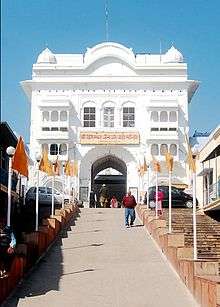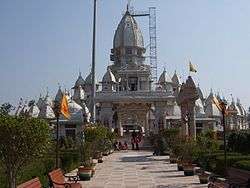Hastinapur
| Hastinapur | |
|---|---|
|
A temple in Hastinapur | |
 Hastinapur Location in Uttar Pradesh, India | |
| Coordinates: 29°10′N 78°01′E / 29.17°N 78.02°ECoordinates: 29°10′N 78°01′E / 29.17°N 78.02°E | |
| Country | India |
| State | Uttar Pradesh |
| District | Meerut |
| Elevation | 202 m (663 ft) |
| Population (2001) | |
| • Total | 21,248 |
| Languages | |
| • Official | Hindi |
| Time zone | IST (UTC+5:30) |
| PIN | 250404 |
Hastinapur (Hindi: हस्तिनापुर, Sanskrit: हास्तिनपुरम् Hāstinapuram) is a town and a nagar panchayat in Meerut district in the Indian state of Uttar Pradesh.
Etymology
Hastinapuram (Sanskrit) Hastin (elephant) + puram (city) is a city named after the elephants. History of this place begins from the period of Mahabharata. It is also said that this place is named after the King Hastin. After few generations Kuru born and so called Kuru dynasty came into existence. It is also described as Gajpur, Nagpur, Asandivat, Brahmasthal, Shanti Nagar and Kunjarpur in ancient texts.
History

Located on the right bank of an old bed of the Ganga, known in literature and tradition as the capital of the Kauravas of the Mahabharata fame. Hastinapur was the capital of the Kuru Kingdom. All incidents in the epic Mahabharata have taken place in the city of Hastinapur. The birth of the Mahabharata villains, the 100 Kauravas, happened here, by their mother, Queen Gandhari, wife of King Dhritarashtra. On the bank of the Budhi Ganga, two places known as Draupadi Ghat[1] and Karna Ghat remind one of the Mahabharata personages.
The first reference to Hastinapur in Puranas comes as the capital of Emperor Bharata. Samrat Samprati, the grandson of the emperor Asoka the Great, of the Mauryan Empire, built many temples here during his empire. The ancient temple and stupas are not present today. Excavation at Hastinapur was carried out in the early 1950s by B.B. Lal, Director General of the Archaeological Survey of India. Although the main aim of this excavation, mentioned by Lal himself, was to find out the stratigraphic position of Painted Grey Ware with reference to other known ceramic industries of the early historical period, Lal also ended up making correlations between the text of the Mahabharata and the material remains that he uncovered at Hastinapur. This exercise led him to historicize some of the traditions mentioned in the text, as well as link the appearance of the Painted Grey Ware with Aryans in upper Ganges basin areas.[2] Though pre-history of Hastinapur is not clear as full scale excavation could not be undertaken in inhabited area. In the medieval era, Hastinapur was attacked by Mughal ruler Babur when invading Hindustan. During British India, Hastinapur was ruled by the Gujjar Raja Nain Singh Nagar. He built many Hindu temples in and around Hastinapura.[3]
Geography and climate
In the present-day Hastinapur is a town in the Doab region of Uttar Pradesh in India around 37 km from Meerut and 90 km north-east of Delhi on National Highway 119. It is a small township re-established by Jawaharlal Nehru on February 6, 1949. Hastinapur is located at 29°10′N 78°01′E / 29.17°N 78.02°E.[4] Hastinapur has an average elevation of 218 metres, and it experiences extremes of climate similar to the other cities of Uttar Pradesh. The summer season is from the month of March to the month of May, during which the temperatures vary from a minimum of about 32 °C to about 40 °C. The monsoon season is from July to September, and temperatures during this time are usually moderately low. In winter (between December and February), temperatures can drop to nearly 5 °C and usually don't rise beyond 14 °C, with December being the coldest month in the year.
Demographics
As of 2001 India census, Hastinapur had a population of 21,248. Males constitute 53% of the population and females 47%. Hastinapur has an average literacy rate of 73.9%, above than the national average of 59.5%. In Hastinapur, 15% of the population is under 10 years of age.[5]
Places of interest
Located on the banks of old ravine of Ganges, Hastinapur is considered one of the holiest place by both Hindus and Jains alike. It is believed to be the birthplace of three Jain Tirthankaras. There are many ancient Hindu temples, Pandeshwar Temple, Karna Temple and Jain temples such as Shri Digamber Jain Mandir, Jambudweep, Kailash Parvat, Shwetambar Jain Temple. Apart from these temples, a nearby Gurdwara and Hastinapur Sanctuary are also popular among tourists.
Temples and monuments
Shri Digamber Jain Prachin Bada Mandir

Shri Digamber Jain Bada Mandir is the oldest Jain Temple in Hastinapur. The main temple is believed to be built in the year 1801 under the auspices of Raja Harsukh Rai, who was the imperial treasurer of the Emperor Shah Alam II.[6][7] The principal deity in the main temple is of 16th Jain Tirthankar, Shri Shantinath in Padmasana posture. The altar also has idols of 17th and 18th Tirthankara, Shri Kunthunath and Shri Aranath on each side.[8] There are dozens of other temples and historical monuments in the premises which were mostly built in the late 20th century. Shri Digamber Jain Mandir Tirth Kshetra Committee is also managing numerous Dharamshalas for Jain pilgrims. It has many other facilities including Post Office, Police Sub-station, Jain Gurukul and Udaseen ashram. There are nearby sites of tourist attraction as well, like Jal Mandir, Jain Library, Acharya Vidyanand Museum, 24 Tonks and ancient Nishiyaji’s, situated few kilometres from the main temple.[9]
Kailash Parvat Rachna

Kailash Parvat is a 131 feet high structure, constructed under the aegis of Shri Digamber Jain Mandir Hastinapur. The principal deity here is of Rishabhanatha, the first Tirthankara. The Panch-kalyanak Pratishtha Mahotsava of Kailash Parvat was accomplished in April 2006. Kailash Parvat premises has various Jain Temples, Yatri Niwas, Bhojanshala, Auditorium, Helipad and lots of tourist attractions.[10][11]
Jambudweep Jain Tirth

Jambudweep depicting the model Jain cosmology has been designed here under the supervision of Shri Gyanmati Mataji was in 1985. The premises has various Jain temples which includes Sumeru Parvat, Lotus Temple, Teen Murti Mandir, Meditation Temple, Badi Murti, Teen Lok Rachna and many other tourist attractions.[12]
Shri Shwetambar Jain Temple
The Shwetambar temple is renovated recently and the re-establishment took place on Margashirsha Shukla of VS 2021. Ashtapad Teerth built under the aegis of Shri Shwetambar Jain Temple is 151 feet high structure.[13] The architectural details of this monument is worth being seen. The Panch-kalyanak Pratishtha took place in December 2009 under nishra of Gachhadipati Acharya Nityanand Surishwerji. Jain Sthanak is also situated near to Shwetambar Jain Temple.[14]
Pandeshwar Temple
Located in the ruins of the old city of Hastinapur, Pandeshwar temple, believed to be around 7000-year-old [15] is dedicated to Lord Shiva.This temple is believed to be a place where Kauravas and Pandavas took education of Vedas and Puranas. A temple of Goddess Kali and many Hindu Ashrams are also present on hillock of the ruins.
Karna Temple
Karna Temple dated to about 4000 B.C.[16] is situated near to Pandeshwar temple, lies on the bank of old ravine of Ganges. The Shivling inside Karna temple is said to be established by Karna, one of the central figures in the epic of Mahabharata.[17]
Bhai Dharam Singh Gurdwara
It is a small Gurdwara located in a village Saifpur, some 2.5 km (1.6 mi) away from Hastinapur. Bhai Dharam Singh (1666–1708) was one of the Panj Pyare (Punjabi: ਪੰਜ ਪਿਆਰੇ) or the Five Beloved, the forerunners of Khalsa. He was the son of Bhai Sant Ram of the village Saifpur.[18][19]
Hastinapur Sanctuary
Hastinapur Sanctuary is one of the prominent wildlife projects in India. It was constituted in the year 1986. The sanctuary extends over a wide area of Meerut, Bijnore, Hapur and Jyotiba Phule Nagar in Uttar Pradesh. The Hastinapur Sanctuary is a sprawling forest occupying the area of 2073 km2.[20][21]
Festivals and fairs
Various cultural and religious fairs are held here round the year, like Akshaya Tritiya, Das Lakshana, Kartik mela, Holi mela, Durga Puja and many other programs are organised by NGOs and the tourism department round the year.
See also
References
- ↑ "Excavation Sites in Uttar Pradesh - Archaeological Survey of India". asi.nic.in.
- ↑ "Excavation Sites in Uttar Pradesh - Archaeological Survey of India". asi.nic.in. Retrieved 25 August 2015.
- ↑ "Unreason and Archaeology: The 'Painted Grey-Ware' and Beyond". jstor.org.
- ↑ "Maps, Weather, and Airports for Hastinapur, India". fallingrain.com. Retrieved 25 August 2015.
- ↑ "Census of India 2001: Data from the 2001 Census, including cities, villages and towns (Provisional)". Census Commission of India. Archived from the original on 2004-06-16. Retrieved 2008-11-01.
- ↑ http://mdameerut.in/major-attraction/
- ↑ http://www.digambarjainonline.com/pilgri/hastina.htm
- ↑ A Review of World Antiquarianism: Comparative Perspectives. Getty Publications. p. 431. ISBN 978-1606061480.
- ↑ "Shri Digamber Jain Prachin Bada Mandir Hastinapur, Meerut(U.P.), Jain Mandir, Mandir, Mandir in Hastinapur, Mandir in Uttar Pradesh, Mandir in India, Jain bada mandir in hastinapur, Shri Digamber Jain Mandir, Shri Digamber Jain Prachin Mandir, Shri Digamber Jain Bada Mandir". jainbaramandirhtr.com. Retrieved 25 August 2015.
- ↑ "Home". kailashparvat.org. Retrieved 25 August 2015.
- ↑ "WWW.JAINHERITAGECENTRES.COM > Jainism In India > Uttar Pradesh > Hastinapur > Kailash parvat Mandir". jainheritagecentres.com. Retrieved 25 August 2015.
- ↑ "Home". jambudweep.org. Retrieved 25 August 2015.
- ↑ "on www.jainsamaj.org ( Jainism, Ahimsa News, Religion, Non-Violence, Culture, Vegetarianism, Meditation, India. )". jainsamaj.org. Retrieved 25 August 2015.
- ↑ "HereNow4U.net :: Article Archive - The 151 Foot High Ashtapad Teerth in Hastinapur". HereNow4u: Portal on Jainism and next level consciousness. Retrieved 25 August 2015.
- ↑ "Work on Mahabharat Circuit to start soon". The Hindu. Retrieved 25 August 2015.
- ↑ "Work on Mahabharat Circuit to start soon". The Hindu. Retrieved 25 August 2015.
- ↑ "Work on Mahabharat Circuit to start soon". The Hindu. Retrieved 25 August 2015.
- ↑ "Bhai Dharam Sing Gurdwara - Hastinapur - Bhai Dharam Sing Gurdwara Photos, Sightseeing - Native Planet". nativeplanet.com. Retrieved 25 August 2015.
- ↑ http://www.up-tourism.com/destination/meerut/excursions.htm
- ↑ "Hastinapur sanctuary". The Hindu. Retrieved 25 August 2015.
- ↑ "Hastinapur Sanctuary". indiatravelfaq.com. Retrieved 25 August 2015.
External links
-
 Media related to Hastinapur at Wikimedia Commons
Media related to Hastinapur at Wikimedia Commons
